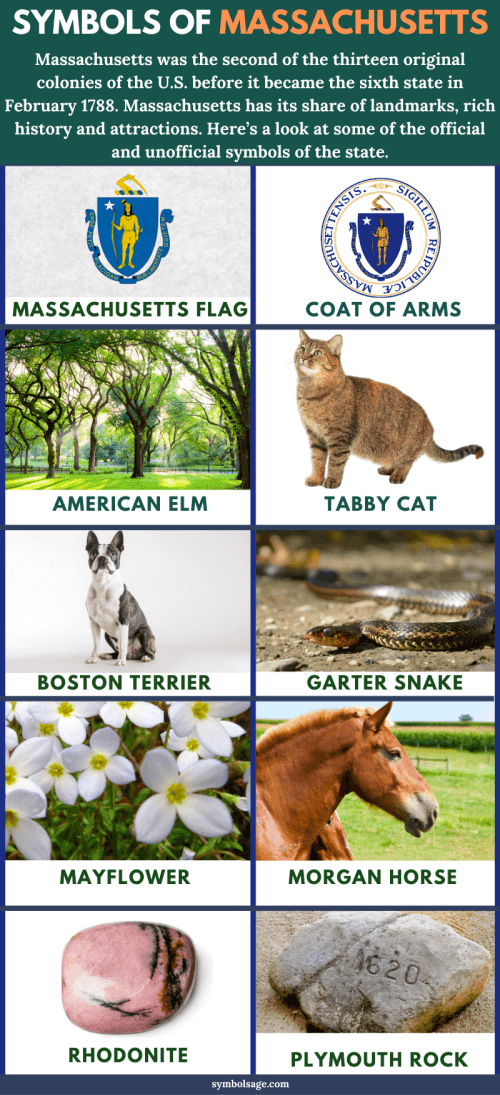
Table of Contents
Massachusetts was the second of the thirteen original colonies of the U.S. before it became the sixth state in February 1788. It’s one of four states that call themselves a commonwealth state (the others being Kentucky, Pennsylvania and Virginia) and the third most populated in America. Nicknamed the Bay State, Massachusetts is home to Harvard University, the first institution of higher learning established in the U.S in 1636 and a host of other colleges and universities.
Like all other states in the country, Massachusetts has its share of landmarks, rich history and attractions. In this article, we’re going to be taking a close look at some of the official and unofficial symbols of the state.

Coat of Arms of Massachusetts
The official coat of arms of Massachusetts displays a shield in the center with an Algonquian Native American holding a bow and arrow. The current seal was adopted in 1890, replacing the Native American with a composite whose head is that of a Chippewa chief of Montana.
The arrow points downwards, symbolizing peace and the white, five-pointed star next to his head signifies, the Commonwealth of Massachusetts as one of the U.S. states. Surrounding the shield is a blue ribbon bearing the state motto and on top is the military crest, a bent arm holding a broadsword with the blade facing upward. This represents that liberty was won through the American Revolution.
Flag of Massachusetts
The state flag of the Commonwealth of Massachusetts features the coat of arms in the center of a white field. In the original design, adopted in 1915, a pine tree was featured on one side and the Commonwealth coat of arms on the other, as the pine tree was a symbol of the value of wood to the early settlers of Massachusetts. However, the pine tree was later replaced by the coat of arms which is seen depicted on both sides of the flag in the current design. It was approved in 1971 and has remained in use to this day.
Seal of Massachusetts
Adopted in 1780 by Governor John Hancock, the state seal of Massachusetts bears the state coat of arms as its central element with ‘Sigillum Reipublicae Massachusettensis’ (the Seal of the Republic of Massachusetts) encircling it. Since it was adopted, the seal has been modified several times until its present design, drawn by Edmund H. Garrett was finally adopted by the state in 1900. The state has been considering changing the seal since as some think it doesn’t portray equality. They say that it looks more symbolic of violent colonization which led to loss of land and lives for the Native Americans.
The American Elm
The American Elm (Ulmus Americana) is an extremely hardy species of tree, native to eastern North America. It’s a deciduous tree which has the ability to withstand temperatures as low as minus 42oC and lives for hundreds of years. In 1975, General George Washington was commissioned to take command of the Continental Army, which took place beneath an American elm. Later, in 1941, the tree was named the state tree of Massachusetts to commemorate this incident.
Boston Terrier
The Boston Terrier is a non-sporting breed of dog that originated in the U.S.A. These dogs are compact and small with erect ears and short tails. They’re extremely intelligent, easy to train, friendly and known for their stubbornness. Their average life span is 11-13 years although some have been known to live for up to 18 years and they’ve got short noses which can cause breathing difficulties later in life which is the main reason for the low life expectancy.
In 1979, the Boston Terrier was designated the state dog of Massachusetts and in 2019 it was ranked the 21st most popular dog breed by the American Kennel Club.
Massachusetts Peace Statue
The Massachusetts Peace Statue is a war memorial statue in Orange, Massachusetts, built to honor the veterans who served in WWII. In February, 2000, it was adopted as the official peace statue of the State of the Massachusetts. It was sculpted in 1934 and depicts a weary doughboy seated on a stump with an American schoolboy standing next to him, who seems to be listening intently to what the soldier is saying. With its inscription ‘It Shall Not Be Again’, the statue symbolizes the need for world peace and is known to be the only one of its kind.
Garter Snake
Endemic to Central and North America, the Garter snake (Thamnophis sirtalis) is a small to medium-sized snake that’s present throughout North America. It’s not a harmful snake but it does produce venom that’s neurotoxic and can cause swelling or bruising. Garter snakes feed on garden pests such as slugs, leeches, rodents and earthworms and they also feed on other little snakes.
In 2007, the garter snake was named the official state reptile of the Commonwealth of Massachusetts. It’s commonly known as a symbol of dishonesty or jealous but in some American tribes, it’s seen as a symbol of water.
The Mayflower
The mayflower is a spring-blooming wildflower that’s native to North America and Europe. It’s a low, evergreen, woody plant with fragile, shallow roots and shiny, dark green leaves which are oval-shaped. The flower itself is pink and white in color and shaped like trumpets. They form little clusters and have a spicy scent to them. Mayflowers are commonly seen in barren lands, rocky pastures and grassy areas, wherever the soil is well-drained and acidic. In 1918, the mayflower was designated as the state flower of Massachusetts by the legislature.
The Morgan Horse
One of the earliest known horse breeds that developed in the United States, the Morgan horse served several roles throughout the history of America. It was named after Justin Morgan, a horseman who moved to Vermont from Massachusetts, acquired a bay colored colt and gave him the name Figure. Figure became popularly known as the ‘Justin Morgan horse’ and the name stuck.
In the 19th century, the Morgan horse was used for harness racing, as a coach horse and cavalry horse as well. The Morgan is a refined, compact breed that’s generally bay, black or chestnut in color and is famous for its versatility. Today, it’s the state horse of the Commonwealth of Massachusetts.
Rhodonite
Rhodonite is a manganese silicate mineral composed of significant amounts of magnesium, calcium and iron. It’s pink in color and usually found in metamorphic rocks. Rhodonites are hard minerals that were once used as manganese ore in India. Today, they’re only used as lapidary materials and mineral specimens. The Rhodonite is found all throughout the United States of America and is considered the most beautiful gemstone found in Massachusetts leading to its designated as the official state gemstone in 1979.
Song: All Hail to Massachusetts and Massachusetts
The song ‘All Hail to Massachusetts’, written and composed by Arthur J. Marsh, was made the unofficial song of the Commonwealth state of Massachusetts in 1966 but in 1981 it was written into law by Massachusetts Legislature. Its lyrics celebrate the state’s long and rich history and it also mentions several items that are strongly associated with Massachusetts like cod, baked beans and the Massachusetts Bay (nicknamed the ‘Bay State’).
Although it’s the official state song, another folk song called ‘Massachusetts’ written by Arlo Guther was also adopted along with several other songs.
Worcester Southwest Asia War Veterans’ Memorial
In 1993, the Southwest Asia War Memorial was constructed in Worcester, the city and the county seat of Worcester County, Massachusetts by the Desert Calm Committee. It’s the official monument of the state for the Southwest Asia War Veterans and was built in memory of all those who gave their lives in the Desert Storm conflict.
Rolling Rock
The Rolling Rock is an oval-shaped rock that sits atop a stone pedestal in Fall River city, Massachusetts. It was designated as the official state rock in 2008. The rock has remained where it is thanks to the hard work and dedication of the Fall River citizens who in the early 20th century, who fought to protect it from the forces of traffic safety. It’s said that the local Native Americans used the rock in the past to torture prisoners by rolling it back and forth onto their limbs (which is how it got its name). However, by the 1860s, the Native Americans were gone from the area and the rock was carefully anchored in place so that it would no longer crush limbs.
The National Monument to the Forefathers
Known as the Pilgrim Monument in the past, the National Monument to the Forefathers is a granite monument that stands in Plymouth, Massachusetts. It was built in 1889 to commemorate the ‘Mayflower Pilgrims’ and honor their religious ideals.
It took 30 years to build the monument which depicts a 36-foot-tall sculpture at the top representing ‘Faith’ and sitting on the buttresses are small allegorical figures, each of them carved from a whole block of granite. In total, the monument reaches 81 feet and is thought to be the largest solid granite monument in the world.
Plymouth Rock
Located on the shore of Plymouth Harbor, Massachusetts, Plymouth Rock reportedly marks the exact spot where the Mayflower Pilgrims set foot in 1620. It was first referred to in 1715 as a ‘great rock’ but it was only 121 years after the first Pilgrims arrived in Plymouth that the connection of the rock with the Pilgrims’ landing place was made. As such, it holds great significance as it symbolizes the eventual establishment of the United States.
Tabby Cat
The tabby cat (Felis familiaris) is any domestic cat with a distinguished ‘M’ shaped mark on its forehead, with stripes across the cheeks, near the eyes, around their legs and tail and on its back. Tabby isn’t a breed of cat, but the type of coat seen in domestic cats. Their stripes are either bold or muted and there can be swirls, spots or the stripes appear in patches.
The tabby cat was designated as the official state cat in Massachusetts in 1988, an action which was taken in response to the request of schoolchildren of Massachusetts.
Check out our related articles on other popular state symbols:
Symbols of Hawaii
Symbols of California





